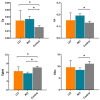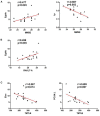Disrupted topological properties of the structural brain network in patients with cerebellar infarction on different sides are associated with cognitive impairment
- PMID: 36203973
- PMCID: PMC9530262
- DOI: 10.3389/fneur.2022.982630
Disrupted topological properties of the structural brain network in patients with cerebellar infarction on different sides are associated with cognitive impairment
Abstract
Purpose: To explore changes in the brain structural network in patients with cerebellar infarction on different sides and their correlations with changes in cognitive function.
Methods: Nineteen patients with acute left posterior cerebellar infarction and 18 patients with acute right posterior cerebellar infarction seen from July 2016 to September 2019 in the Department of Neurology, Affiliated Brain Hospital of Nanjing Medical University, were selected. A total of 27 healthy controls matched for sex, age, and years of education were recruited. The subjects underwent head diffusion magnetic resonance imaging examination and neuropsychological cognitive scale evaluation, and we analyzed changes in brain structural network properties in patients with cerebellar infarction and their correlation with changes in patients' cognitive function.
Results: The Mini-Mental Status Examination (MMSE), Montreal Cognitive Assessment (MOCA) and the Rey auditory verbal learning test (RAVLT) scores in the left and right cerebellar infarction groups were significantly lower than those in the healthy control group (p < 0.05). In addition, the digit span test (DST) scores were lower in the left cerebellar infarction group (p < 0.05); the trail-making test (TMT) times in the right cerebellar infarction group were significantly higher than those in the left cerebellar infarction group (p < 0.05). Meanwhile, the left and right cerebellar infarction groups had abnormal brain topological properties, including clustering coefficient, shortest path length, global efficiency, local efficiency and nodal efficiency. After unilateral cerebellar infarction, bilateral cerebral nodal efficiency was abnormal. Correlation analysis showed that there was a close correlation between decreased processing speed in patients with left cerebellar infarction and decreased efficiency of right cerebral nodes (p < 0.05), and there was a close relationship between executive dysfunction and decreased efficiency of left cerebral nodes in patients with right cerebellar infarction (p < 0.05).
Conclusion: Patients with cerebellar infarction have cognitive impairment. Unilateral cerebellar infarction can reduce the network efficiency of key regions in the bilateral cerebral hemispheres, and these abnormal changes are closely related to patient cognitive impairment. The results of this study provide evidence for understanding the underlying neural mechanisms of cerebellar cognitive impairment and suggest that brain topological network properties may be markers of cerebellar cognitive impairment.
Keywords: brain network; cerebellar infarction; cognitive impairment; diffusion tensor imaging; graph theory.
Copyright © 2022 Wang, Yao, Lin, Hu and Shi.
Conflict of interest statement
The authors declare that the research was conducted in the absence of any commercial or financial relationships that could be construed as a potential conflict of interest.
Figures





Similar articles
-
Topological Disruption of Structural Brain Networks in Patients With Cognitive Impairment Following Cerebellar Infarction.Front Neurol. 2019 Jul 19;10:759. doi: 10.3389/fneur.2019.00759. eCollection 2019. Front Neurol. 2019. PMID: 31379713 Free PMC article.
-
Impaired functional network properties contribute to white matter hyperintensity related cognitive decline in patients with cerebral small vessel disease.BMC Med Imaging. 2022 Mar 9;22(1):40. doi: 10.1186/s12880-022-00769-7. BMC Med Imaging. 2022. PMID: 35264145 Free PMC article.
-
Functional Brain Network Alterations in Patients With Systemic Lupus Erythematosus With Different Cognitive Function States: A Graph Theory Analysis Study.J Comput Assist Tomogr. 2024 Mar-Apr 01;48(2):283-291. doi: 10.1097/RCT.0000000000001546. Epub 2023 Aug 23. J Comput Assist Tomogr. 2024. PMID: 37757812
-
Altered brain networks and connections in chronic heart failure patients complicated with cognitive impairment.Front Aging Neurosci. 2023 Apr 14;15:1153496. doi: 10.3389/fnagi.2023.1153496. eCollection 2023. Front Aging Neurosci. 2023. PMID: 37122379 Free PMC article.
-
Diffusion Tensor Imaging Reveals Altered Topological Efficiency of Structural Networks in Type-2 Diabetes Patients With and Without Mild Cognitive Impairment.J Magn Reson Imaging. 2022 Mar;55(3):917-927. doi: 10.1002/jmri.27884. Epub 2021 Aug 12. J Magn Reson Imaging. 2022. PMID: 34382716
Cited by
-
Cognition in cerebellar disorders: What's in the profile? A systematic review and meta-analysis.J Neurol. 2025 Mar 6;272(3):250. doi: 10.1007/s00415-025-12967-8. J Neurol. 2025. PMID: 40047904 Free PMC article.
-
Effects of Cerebellar Repetitive Transcranial Magnetic Stimulation at Different Frequencies on Working Memory: An EEG Study.CNS Neurosci Ther. 2025 Jul;31(7):e70491. doi: 10.1111/cns.70491. CNS Neurosci Ther. 2025. PMID: 40665925 Free PMC article.
-
Left Cerebellar Lesions may be Associated with an Increase in Spatial Neglect-like Symptoms.Cerebellum. 2024 Apr;23(2):431-443. doi: 10.1007/s12311-023-01542-4. Epub 2023 Mar 30. Cerebellum. 2024. PMID: 36995498
-
Reorganized brain functional network topology in stable and progressive mild cognitive impairment.Front Aging Neurosci. 2024 Nov 18;16:1467054. doi: 10.3389/fnagi.2024.1467054. eCollection 2024. Front Aging Neurosci. 2024. PMID: 39624168 Free PMC article.
References
LinkOut - more resources
Full Text Sources

